
Compiled and researched by Resoum Kidane

Those who had access to education during the Italian rule notably Woldab Woldemariam, Isaac Twelde Medhen and Abdulkadir Kebire and others played an important role in promoting education in the 1940s. They believed that education was the cornerstone for the development of Eritrea. Abdulkadir Kebire also believed that only through education and unity can a people control their own destiny.
In the early 1950s when the Department of Education transferred from the British care-taker administration to the Eritrean government, there was a dramatic expansion in the student population and the number of schools between 1942 and 1952. Over those 10 years of British administration, the British "quadrupled the number of primary schools from twenty-four to 100, and also introduced fourteen middle schools with 1, 200 students, (Gottesmam, Les 1998, page 78.).
During those periods hundreds of schools were opened: 13 in Asmara, 19 in Hamassen, 14 in Saraye, 20 in Akele-Guzie, 15 in Keren and Sahel, 10 in Agordat and 9 in Massawa and Assab. (Taye, 1990). Despite this fact in the 1940s the British showed an unwillingness to expand education beyond 8th grade and the also sold off from Eritrea’s infrastture an estimated £86 million worth of industrial plant & equipment, including port facilities. Hence, once the students completed their junior education the only opportunities they had for work were as interpreters, clerks, teachers and para-professionals.
Later, from the mid-1950s onward, good progress was made by the Eritrean government and students had got the opportunity to pursue their secondary educational level in Eritrea. This was when Haile Selassie I and Prince Makonnon Secondary schools were opened in 1955 and 1956. During the 1956 academic year there were about 250 students enrolled in the two schools.
Profile of some students who started teaching after completing the middle school in 1940s
Mr. Tesfamariam Yohannes Woldemichael was born on September 27, 1935, after completing his elementary education in Segeneiti, he was among the first batch of Eritrean students allowed to go beyond the 4th grade, which had been the limit imposed by Italian colonialism. He attended Biet Gergish in Asmera and completed middle school there. He then completed teachers training and started working as a teacher in both Asmara and Segeneit
It is worth mentioning that very few students who completed elementary or middle school in the 1940s got opportunities to pursue their studies outside Eritrea, in Ethiopia, Khartoum, Cairo and Beriut, to mention a few of them:
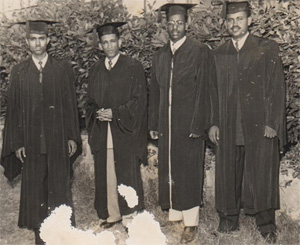
LtR. 1. Saleh A. Kebire, 2. Dr. Seyoum Haregot, 3. Yohannes ? "Ethiopia", 4. Yassin M. Aberra. - The American University of Beirut - Lebanon 1952. Picture Courtesy of Jelal Yassin
Habte Teclemariam provides this piece of information regarding the above picture on facebook. It was during the Federation that they were granted Point Four Scholarship through the Eritrean Government and it was Asfaha Wolldemichael as the Chief Executive who sent them there. Dr. Seyoum relates that he had begun studying at Addis Ababba University but discontinued it to go to Beirut, where he got a BA degree and then attended graduate school in Syracuse before he moved to Harvard for the JD degree.
Habte Teclemariam also adds in his comment on facebook. Rebina Yerhamuhoum, Dr Yassin was young and very energetic. He was a legend in his own life time. He got his first dgree from the American University of Beirut. The man you see sitting next to him is the one who sent them there. Seyum Haregot, Yassin and Saleh Kebire were sent to AUB. Dr. Yassin got his Ph.D from a German Univrsity, I forget what school he went to but he did tell me at one time that he was at Heidelberg. .
Generally speaking the British Administration in Eritrea contributed a great deal toward the development of education between 1942 and 1951. Regarding this Woldeyesus Ammar, states that the British care-taker administration (1941-1952) promoted education and this policy was continued by the Eritrean Government formed under the federal arrangement.
During the Federation Period with Ethiopia the enthusiasm for education that was aroused during the British Administration continued. There was an increase in recruitment of teachers, student enrollment and expanding education beyond the grade 8th. This section covers an overview on the progress made in promoting education by the Eritrean government between 1952 and1962.
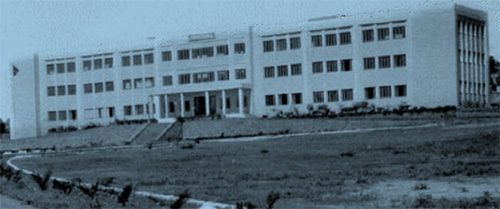
Haile Selassie I Secondary School (HSISS) Credit: Dr Teame Mebrahtu
Haile Selassie I Secondary School (HSISS) the first secondary school to be established in the mid-1950s was funded directly by the Ethiopian government in Addis Ababa. It cost about one million Ethiopian dollars. The school was the most modern type ever created on Ethiopian soil.
During its early years, Haile Selassie I Secondary School (HSISS) was the best endowed and largest secondary school in Eritrea, with both day students and boarders. Ravinder Rena( 2004] Haile Selassie I Secondary School was originally in tended as a boarding school for 450 student; but later, due to the increase in student population and a growing demand for secondary education, the plan was changed. The dining hall and dormitories were converted into classrooms and the capacity of the school was increased to accommodate about 1000 day school students (Taye, 1990, page 81).
As mentioned above Haile Selassie I Secondary School (HSISS) was a boarding school in the 1950s, according Teame all pupils who had successfully Grade 8 throughout Eritrea, took another exam to gain admission to a brand new scondary school in Asmara. It had just been built on the the instructions of the Emperor and named after him-the Hile Selassie Secondary School. The striking looking modern building far outshone the Scuola Vittorio which perhaps was what the Emperor intended. Critics argued that it was a propaganda execise designed to win hearts and minds in a region where he was not popular. Glass fronted, it was built on a hill and could be seen from all over the city. The Emperor was rumoured to have paid for the building himself as a gift to the people of Eritrea. It had attractive dormitories, shiny toilets and shower rooms and the student borders were given three course meals-far in excess of what Eritreans would normally eat.There had never been a school like it in the country. Just fifty-six out of two hundred and fifty students pass the exam to go there Teame was one of them. The results were published in the government newspaper.
There was an impressive opening ceremony with bands playing and many guest including the student's families and local dignitaries. Teame was registered in Grade 9. He discovered a few days later that some students from Grade 10, 11 and 12 at Scola Vittorio who had also gained places without having to pass an examination, had been put in Grade 10 at Haile Selassie I Secondary School (HSISS). Teame never discovered why but suspected the authorities wanted to send out a signal that the Ethiopian curriculum was of a higher standard than the Eritrean version.
The school headmaster was a Canadian, with an Ethiopian administrator and the teaching staff made up of British, Indian, American and Ethiopian academics. Lessons each day started with an Ethiopian flag hoisting ceremony-something the Eritrean students disliked. source Hazell, Stan, 2017 pp40-41
Prince Mekonnon Secondary School
After the opening of the secondary school many students from the provincial town were forced with considerable difficulties in their pursuit of secondary school education in Asmara and thousands of students had to discontinue their studies for lack of accommodation there. To solve this problem, the second secondary school was called Prince Mekonnon Secondary School was opened.
The Prince Makonnon Secondary School (PMSS) was the only one funded by local sources (Connell, 2011, page 426). Initially, this school was one of the middle schools in Asmara. Grade nine was opened for the first time in 1956-57. Then step by step the school reached grade 12. The running cost of Prince Mekonnon Secondary school was maintained by the Eritrean government. [ Taye 1990, page 82)
Connell( 2011, page 426) adds that a third , the Camboni Scholl for boys, was privately funded and operated by the Catholic Church.
Based on the Ethiopian Journal of Education published 1974, the total enrollment in Eritrean secondary schools for the year 1961-62 was 795 and 53 male and female respectively [Taye, 1990, page 83].
Table
1.: Percentage increase of Enrollment,
Teachers and Schools (1956-57 to 1959-60)
|
1956-57
|
1957-58
|
1958-59
|
1959-60
|
Enrollment
Empire total
12 Provinces
Addis Abeba
|
24.43
23.30
26.38
27.16
|
12.98
14.87
14.97
4.45
|
5.48
4.66
0.59
15.12
|
7.94
3.31
2.57
23.27
|
Teachers
Empire total
12 Provinces
Addis Abeba
|
15.33
12.53
12.55
27.31
|
11.14
13.89
12.76
3.46
|
13.31
6.81
28.41
18.97
|
2.35
4.14
3.54
4.69
|
Schools
Empire total
12 Province
Addis Abeba
|
4.99
3.11
8.57
10.15
|
2.78
6.49
10.52
10.63
|
1.59
4.57
9.52
21.42
|
0.94
.68
4.34
4.37
|
Generally prior
to 1962 the number of students and
teachers were higher in
2. Tertiary level education
Santa Famila University/University of Asmara
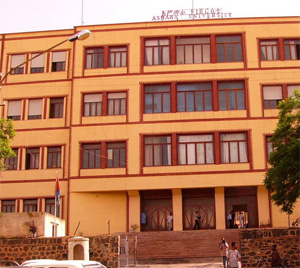
The University of Asmara ( known as the Santa Famila University) was officially established on 20 December 1958 by the Missionary Congregation Pie Madri della Nigrizia of Verona, Italy, and the courses were in Italian. The purpose of the taught courses was to prepare students for the final year of study in an Italian University (Laurea. In 1959, the university was recognized by the then Eritrean Government
During that year Degiatch Hadgu Ghiliagabir, Degiatch Zerom Kifle, Degiatch Fessahaie Tesfamichael, and Fitawrary Mikael Hasama Raka submitted a petition to the Vatican for financial aid to build a university in Asmara. This was handed over to the "Nunzio Apostolico," who was on a visit to Asmara in 1959.
The proposal was favourably considered and the Santa Famiglia Institution entrusted with the job of building the university, which was completed and started operating in the 1970s. Although it received the approval of the emperor and the grant of $40,000 aid per year, the Ministry of Education refused to recognize the university and it remained unrecognized until the fall of the regime. (Mikael Hasama Raka 1984)
Gottesman, Lespp (1998, pages 81-8 )also states that the Italian community in Asmara, historically hostile to Eritreans obtaining an education, conspired with the ministry of Education to prevent the university's campus being built. Eventually, the university's lawsuit won on appeal and the building was completed.
In 1960, a pre-university one year programme entry into the University was recognized by the Superior Council of the Italian University and in 1962 it changed its name from the Santa Famila to the University of Asmara after obtaining recognition from the Ethiopian government.
In 1964 the Emperor Haile Selassie attended the ceremony of laying the first stone in its Main Building. The University College was inaugurated offering in 1964 Associate Diploma programmes in arts, commerce and science. In that year, English was adopted as the medium of instruction in addition to Italian. The university made good progress in the enrolment of students. In the late 1960s udents numbers exceeded 1,500. In 1964, there had been only 486 students.
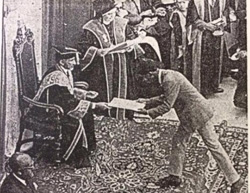
Haile Selassie presenting diplomas to graduating students at the University of Asmara, published in the Kagnew Gazelle in 1969 sourceSkip Dahlgren facebook
Asmara University History and Contributions
by Dr Chefena Hailemariam
This is a Summary of Dr Chefena’s presentation at the Inaugural meeting and annual celebration of Asmara University Alumni Society in the United Kingdom (AUAS-UK) London 17 July 2016
Here is the gist of my presentation on the on a brief history of the formative year of the UoA and its contribution to the Eritrean Society
I started my talk by lay down reasons that motivated me to researching and documenting the history of the University of Asmara. The presentation was meant to provide a brief background knowledge of the formative years of the UoA. It covered the years between when the idea of founding of higher institution of learning was contemplated up to the time when the then King Hailesellassie appointed the first Ethiopian Government appointed president.
I introduced the two dedicated Italian Combonians Sister Marianora Onnnis and Sister Fosca Berrardi and their invaluable contribution to the people of Eritrea. The two nuns along with a few Eritrean intellectuals of that era were the main actors in making the dream of building a university a reality. The fact the UoA had always remained an Eritrean university could be supported by the fact that the then Federal Government of Eritrea had granted it a constitution in 1961. The birth of the Santa Famila with its experimental educational programmes in 1958 was to foreshadow the founding of the UoA. I highlighted how the two nuns had to meet the obstacles that stood at each stage of their efforts to acquiring a space (building) and securing internal recognition. They worked hard to persuade the King to support them get the approval of the Ethiopian Ministry of Education that continued to block the developments towards a full-fledged university. They used their personal connection to have access to the corridors of power to have the King approve the University of Asmara Charter in 1968. But, I pointed out the stigma the university carried has persisted for some years to come.
Towards the end, I presented some episodes than marked further Ethiopianization of the UoA in terms of expansion of academic programmes and an allocation of government funds. The process was preceded by evaluation of the educational programmes and provide further academic support to the university. This was spearheaded by the Hailesellasis University academic senate. After the team submitted their report, the head of the team, an Eritrean academic and one of the founders of the Ethiopian medical school was appointed to be the president of the University of Asmara in 1972. During his time Student Association University of Asmara (SAUA) was established. That was when the students, through SAUA, became heavily involved in political affairs of Eritrean national liberation. SAUA was instrumental in getting its members join the ranks of the ELF.
In the end I recounted, the successes of the university in the academic sense despite the kind of negative image its detractors wished to paint. I made mention to some formed students of the UOA who gained some fame in Eritrean political field. I also recounted that the graduates of the UoA had demonstrated their academic competence in post-graduate studies in many prestigious worlds academic institution. Finally, fast-forward, I referred the listeners to note a curious paradox in the history of Eritrean higher education system. Apparently the Eritrean higher education authorities are in the inquest of international recognition for their newly founded colleges. I said in Tigrinya we saw that there was a UaA that had earned its international recognition fifty years now. In effect, this can be compared to throwing away ones key deliberately into a pond or a pool and after a while one struggles to get it.
By and large, this can be taken as a ‘snap-shot’ presentation of the formative years of the UoA than a detailed narrative account the sequence of events through the formative phase.
In the 1950s, there were also more than 300 Eritrean students pursuing higher education in studies in Cairo. According Connell (2011, page 482) Muslim students with nationalist sentiments generally left Eritrea to study in the Arab world, particularly after Arabic was banned in the schools in favour of the emperor's language, Amharic.In late 1950s, they formed an Eritrean Students' Union in Cairo, led by Seid Hussein.Seid Hussein

ሰዒድ ሁሴን መራሒ ኤርትራዊያን ተማሃሮ አብ ካይሮ ካብ መስረትታ ተሐኤ ን ቀዳሞት ተጋደልቲ፡ ብ1963 አብ ሰንበል ነፉሪት ከቃጽል ፈቲኑ ተታሒዙ፡ ብ1975 ተሐኤ ተፈቲሑ ብ1978 ድማ ብተሐኤ አብ ደንካሊያ ተቀቲሉ
ክበብ ኤርትራዊያን ተማሃሮ አብ ካይሮ
ክበብ ኤርትራዊያን ተማሃሮ አብ ካይሮ አብ ጥሪ 21 1852 ተመስሪቱ እቲ ክበብ ወግዓዊ ወኪል ኤርትራዊያን ዜጋታት አብ ምስሪ ብምኻን ብመንገዱ አቢሉ ዩ ማህደረ ትምህርቲ ዝረክቡ ዝነበረ.. ኣብ ትሕቲ ሓልዮት ኤምባሲ ሃገር ኤርትራ አብ ካይሮ ብዕለ 25/01/2002 መበል 50 ዓመት ዝኽሪ ምምስራት ክበብ ኤርትራዊያን ተማሃሮ አብ ካይሮ ሕጽር ዝበለ ታሪክ ናይቲ ክበብ ብመልክዕ ቡክለት ተዳሊዉ ነይሩ:መሐመድ ፉይድ አብ ሐምሳታት ሚኒተስር ዜና ግብጺ ዝነበረ አብ ኢትዮጵያ ክኸዉን ንፕሬሲዳንት ናስር ከም ዝሐተተ ፕሬሲዳንት ናስር ግን እቲ ጉዳይ ነተን ናጻ ምምሕዳር ዘሎወን ትካላት ትምህርቲ ግብጺ ከምዝምልከተን አቡኡ ኢዱ ከም ዘይእቱ ሐበሮ ይብል መሐመድ ፉይድ:: ዶክተር አል ስይድ ፍሌፍል ዲን ማእከል ምርምርን መጽናዕትን አፍሪቃ አብ ዝኽሪ 50 ዓመት ናይቲ ክበብ ዘቕሮቦ ጹሑፍ ከም ዝሐበሮ እቶም ነዚ ክበብኣ ሓሳብ ክበግሱ አንክለው ኣብ ኤርትራዊ ሃገራውነት ምርኩስ ብምግባር ኤርትራ አካል ናይ ኢትዮጵያ ክም ዘይኮነት ንዓለም ክፍልጡ ዝወስድዎ ተበግሶ ማአክል ምንቅስቃሶም ነይሩ ይብል
ዶክተር አል ስይድ ፍሌፍል ብተወሳኺ ግብጺ ንኤርትራዊያን ተማሃሮ ክትቅበል እንከላ ብዘይ ሃይማኖታዊ አፈላላይ እስላማይ ናብ አል አዝሃር ክርስትያን ድማ ናብ ቤት ክርስትያን ተዋሃዶ ብምልአኽ ትሰርሕ ከም ዝነበረት ይሕብር በዚ ድማ ከም ንህዝቢ ግብጺ ሐድነት ብምኽባር ዝሰረሐት ንኤርትራዊያን ሃገራዊ ሐድነት አብ ምድልዳል ተርአ ከም ዘበርከተት ይሕብር:: ወከልቲ እቲ ክበብ ኣብቲ ብ1959 ኣብ ባንዶግ ኢንዶነሺያ ዝተጋበአ ዋዕላ መንእስያት አፍሮ ኤስያ ብምስታፍ ብዛዕባ ጉዳይ ኤርትራን ኩነታት ህዝባን ስፊሕ መብሪሂ ሂቦም
ዝርዝር አስማት ናይ ውሕዳት አባላት ናይ ቲ ክበብን እቲ ብሕጽር ኢሉ ቀሪቡ ዘሎ ሐበሬታ አብ ላዕሊ ካብ ቋንቋ ዓረብ ብመሐሙድ ዑመር ጭሩም ብ2002አምባሳደር ናይ ኤርትራ አብ ካይሮ ዝነበረ ኢዩ ተተርጊሙ.
ዝርዝር ኣስማት ናይ ኤርትራዊያን ተማሃሮ አብ ምስሪ አብ 1950s ዝማሃሩ ዝነበ
ዓብደላ ኽያር
ኣልኣሚን ዑስማን ኣልኣሚን
ዑስማን ኢብራሂም በሽር
መሐመድ ብርሃን ኑር ሑሴን
ዓሊ መሐመድ ጃስር
በሽር ሳልህ
መሐመድ ሸሪፍ ሳልህ
አድሪስ ዓብደል ዓለም
ዓብደል ቃድር ሐጎስ
መሐመድ ዜን ሐሰን
የስሪ በሸር ኢብራሂም
ዓብደላዓብደልራሕማን
መሐመድ አለ ጠይብ እስማዒል
መሐመድ ጣሃ አሕመድ
ስሊም ሐስን ኩርድ
ዑስማን ሳልህ ዳንዳን
ስዒድ ሑሴን መሐመድ
ሱለይማን መሐመድ ዓብዱ
መሐመድ ኢብራሂም ኑዕማን
አድሪስ ክሊፋ
ሱለይማን መሐመድ ኣሕመድ
መሐመድ ዑመር ዓሊ
ዑስማን ስይድ ኣደም
ዓብዱ ኣልኣሚን መንስዓይ
ዓብደል ኻልቅ ሐምድ
መሐመድ ዓሊ ዑመር
Eritrean students pursuing higher education at the American University of Beirut
In the 1950s, there were also more than 800 Eritrean students pursuing higher education at the American University in Beirut :
Sium Haregot graduated in 1952
Yassin Mohamed Aberra, graduated in 1952
Cavalier Nur Hussein, graduated in 1952
Saleh kebire graduated in 1952
Beyene Haile graduated in 1963 in public administration and political science.
During those periods many Eritrean students had also access to secondary and university level education in Ethiopia or were granted scholarship to study abroad, to mention a few of them :
Development of professional education
Nurse education in Eritrea has a history that goes back to 1923 when a course for nurses was started by Swedish Evangelical Mission.(SEM). There was also nursing education for Italian Camboni nuns. However, when Eritrea was mandated by the British Administration in the 1940s, there was no substantial change in the health delivery system or nurse recruitment. At that time there was an Eritrean nurse, Mihret Paulos Men’ Ameno who graduated in Jerusalem and served with the British army in World War II.
In 1952 the Eritrean government created an Eritrean health department which took over the operations of the rudimentary colonial urban-based health system. In the early 1950s nursing education started to produce three kinds of nurses: registered nurses, community nurses, and midwife nurses.
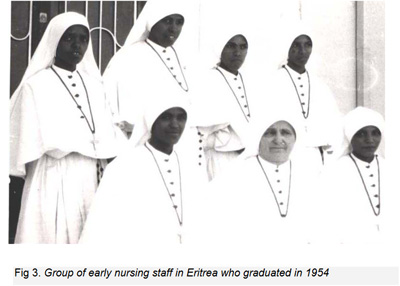
In 1954 these Italian Camboni nuns were replaced by local nurses, who were upgraded to work without salary. Among the first graduates were: s/r Alganesh Haregot and s/r Alganesh Adhanom and other prominent nurses who played a vital role in shaping nursing, and nursing services in Eritrea
Graduation ceremony for nursing health personnel before 1954, and the Diploma http://www.harep.org/Agriculture/Eritrea[1].pdf

Recognizing the continued severe shortages of trained nursing personnel and at the request of the Eritrean government, the Ethiopian government in cooperation with the United States of America acting under its technical assistant programme, established in 1955, the Itegue Menen School of Nursing (later known as Asmara School of Nursing). This school was the primary educational institution for educating nurses in Eritrea.
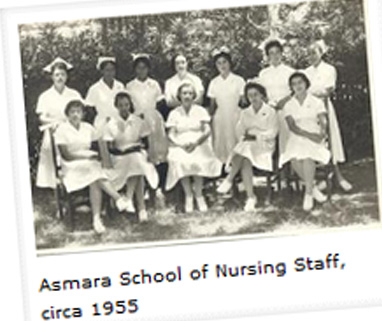
In Feb 1955, the school of nursing admitted its first class of 25 female students out of which 13 students completed the course as nurse midwives. Most of them were assigned to the school of nursing after they were given post basic training in Beirut, Lebanon. After
completion of their courses, those who were prizewinners were sent to America for their bachelors degree in nursing. When they returned home, they were assigned to programmes of administration, teaching, and to the clinical area resulting in better correlation of teaching and improving the quality of students’ clinical experience.
From 1955 to 1958, only female candidates were accepted for training. From 1959 onward, however, it was proposed to also admit young men for training as nurses. [History of nurse]
In 1960’s a number of clinics were opened in smaller towns, staffed by Eritrean dressers and foreign missionaries, such as the American evangelical hospital in Ghindae (1966) and the Lalmba hospital in Keren (1970). The increased nursing population enabled health care services to expand to remote area.
The number of nurses graduated during the period of the federation was follow
Year of Graduation |
Male |
Female |
Total |
1959 |
|
13 |
13 |
1960 |
|
14 |
14 |
1961 |
|
16 |
16 |
1962 |
|
14 |
14 |
1963 |
5 |
12 |
17 |
1964 |
4 |
18 |
22 |
Source: School of Nursing Archive, Asmara cited by Taye 1990, page 88). source
Nurse Ghide who delivered her lecture at American Club Lecture in May 2008 also explained that Asmara’s Nursing School was opened by “Point Four,” an American Mission, in 1955. Since that time, the school has trained more than 3,000 female and male nurses. (http://eritrea.usembassy.gov/may_club_lec.html)
The vocational trade school Point Four
The Eritrean vocational trade school in Asmara was opened in 19 September 1954 in an Italian military barracks. The buildings were renovated and converted for school use by April 1954. It was maintained by the Ethiopian and the Eritrean governments in collaboration with Point Four. 70% of the cost was covered by the Ethiopian government and 30% by the Point Four. The school admitted 101 students from all parts of Eritrea, selected during the summer of 1954. Due to a shortage of grade eight students, many of the first year candidates came from grade six and seven. This had occurred because, in the 1940s, the British Administration in Eritrea didn’t expanded the education beyond the 8th grade.
However later, from September 1955 onwards, with the opening of the secondary school, a vocational trade school, a policy was adopted of accepting only applicants who had completed their eighth grade. The school was a boarding school; it offered a three- year course in theoretical and practical subjects. Since the school was dominated by Americans, it was locally known as Point Four or American school.
Teachers’ training
The teacher training school was opened in 1946 by the British Administration and expanded in 1950s. By 1950, fifty-three men and seven women were training to be teachers. During the Federation period, the training was extended to two years. And the teacher training school became the main supplier of teachers for both primary and middle schools in Eritrea.
Most Eritrean government teachers were recruits from the teachers training set up during the British Administration and after. The number of government school teachers over a period of six years (1955/56-1960/61) grew over 68%(Taye 77-78 1990). One of them was Memhir Yemane Okbagiorgis Tesfamariam who passaway in 2015.
Memhir Yemane and the students of Adi Quala school in the late 1950's
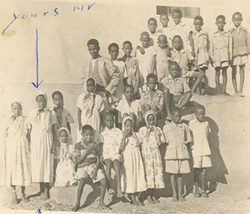
There is a facebook which created for memory of Memhir Yemane Okbagiorghis who dedicated his life for the betterment of Society by educating the young.
ehrea.org © 2004-2017. Contact: rkidane@talk21.com | ||||